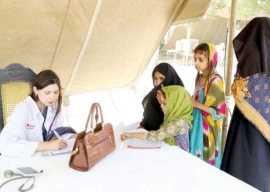With healthcare advice available 24-hours at a basic health unit in Ehsanpur model village and a concrete road to access the hospital in Daira Deen Panah, Rubina Bibi felt safer delivering her fifth child six months ago.
Rubina Bibi and her family, Gadi Baloch, is one of the 166 flood-affected families, who had lived in tents in katcha area on the left bank of River Indus, that have been given houses in a model village in Kot Addu district. The village is built jointly by three non-government organisations: Pakistan Poverty Alleviation Fund (PPAF), Engro Foundation and Farmers Development Foundation on 20 acres of land provided by the provincial government.
Earlier, Rubina says, women at Loomerwallah needed to take a boat ride to the other bank of River Indus and then a journey by road to the hospital. “I suffered a haemorrhage in two of my four deliveries there,” she says. One of Rubina’s sister-in-law died during child birth. “It was very convenient here at Ehsanpur,” she says, “I had ultrasound examinations at the BHU everyday a week before the delivery. I couldn’t have thought about that in Loomerwallah.”
Improvement in healthcare facilities is not the only relief the residents of the model village have received at their new abode. As many as 70 men and 149 women residents of the village have learnt to read and write under an adult literacy programme.
Prayer mats making units have been set up at selected houses in the village where women are being trained in the skill.
A technical training centre has been set up to impart marketable skills like masonry, electronics repairing and welding to the men.
Most of the teenage girls in the village are attending secondary-level classes at a school in the village for the first time.
Laal Khan’s 15-year-old daughter had discontinued studies after fifth class as the only school in Loomerwallah offered education only at primary level for girls. The girl is currently enrolled in a two-year course that will help her sit for matriculation examination. In Loomerwallah, says Rubina Bibi, there was no certainty that there will be classes the next day. She says her children had yet to take a day off from the school in Ehsanpur village.
Laal Khan, 60, earns a living by making prayer mats at one of the home-based units. Each mat sells for Rs5 per feet. Most other men have either taken up daily-wage labour in the nearby towns and cities, work at the village market which has a grocery and tailor’s, butcher’s and cell phone shops. Some of them have gone back to Loomerwallah to harvest wheat crop they have grown on government-owned lands.
Women empowerment
All 950 houses in the village have been registered in the name of a woman head of the family. Ownership will be transferred in their names three years later after the three NGOs will end monitoring and joint administration of public services at the village.
Rubina Bibi’s seven-marla house is registered in the name of her mother-in-law, Hafeez Bibi.
Sobia Jabeen, a livelihood officer and social mobiliser at the Farmers’ Development Organisation says women are listening to them and cooperating with them on issues related to healthcare or education of their children. “There has been a huge change in their (women’s) perception of social workers. Earlier, they would be scared of accompanying us to the bank for opening an account for them,” she says.
Selection criteria
The selection criteria for the families included homelessness, ownership of very few or no livestock and lack of criminal record, Qaiser Khan, the implementation officer at the Ehsanpur model village, told The Express Tribune.
He said cultural sensitivities were also taken into account.
People from the same clan were selected so that they could freely interact with one another at the village. He said they had been careful not to allow local politicians’ from influencing the selection process.
Village
Ehsanpur village is divided in six blocks. Its establishment cost over Rs3 billion. There are two solar panels (each costing Rs225,000) at the village to supply electricity to the houses.
There are livestock enclosures and water purification plants in each of the six blocks.
Published in The Express Tribune, May 21st, 2012.
COMMENTS (4)
Comments are moderated and generally will be posted if they are on-topic and not abusive.
For more information, please see our Comments FAQ



1732259077-0/carti-(1)1732259077-0-165x106.webp)

1726722687-0/Express-Tribune-Web-(9)1726722687-0-270x192.webp)











Excellent effort but it is necessary to monitor this well after the time the builders and volunteers have left otherwise it will crumble and this effort will have gone waste.
@Ali Tanoli: Look at all the people in southern europe - half of whom live on handouts and state welfare; Also look at the UK where a good half of the Muslims live on state khayrat / welfare.
:), and they tell me that Pakistan is a failed state....